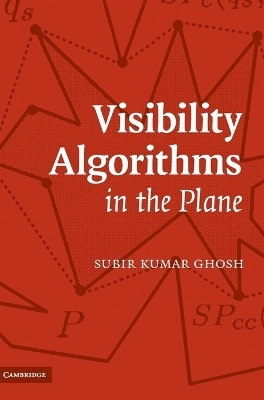
Visibility Algorithms in the Plane
Seiten
2007
Cambridge University Press (Verlag)
978-0-521-87574-5 (ISBN)
Cambridge University Press (Verlag)
978-0-521-87574-5 (ISBN)
Computations of visible portions of objects from a viewpoint involving thousands of objects is a time consuming task even for high speed computers. To solve such visibility problems, efficient algorithms have been designed and this book presents some of these visibility algorithms in two dimensions.
A human observer can effortlessly identify visible portions of geometric objects present in the environment. However, computations of visible portions of objects from a viewpoint involving thousands of objects is a time consuming task even for high speed computers. To solve such visibility problems, efficient algorithms have been designed. This book presents some of these visibility algorithms in two dimensions. Specifically, basic algorithms for point visibility, weak visibility, shortest paths, visibility graphs, link paths and visibility queries are all discussed. Several geometric properties are also established through lemmas and theorems. With over 300 figures and hundreds of exercises, this book is ideal for graduate students and researchers in the field of computational geometry. It will also be useful as a reference for researchers working in algorithms, robotics, computer graphics and geometric graph theory, and some algorithms from the book can be used in a first course in computational geometry.
A human observer can effortlessly identify visible portions of geometric objects present in the environment. However, computations of visible portions of objects from a viewpoint involving thousands of objects is a time consuming task even for high speed computers. To solve such visibility problems, efficient algorithms have been designed. This book presents some of these visibility algorithms in two dimensions. Specifically, basic algorithms for point visibility, weak visibility, shortest paths, visibility graphs, link paths and visibility queries are all discussed. Several geometric properties are also established through lemmas and theorems. With over 300 figures and hundreds of exercises, this book is ideal for graduate students and researchers in the field of computational geometry. It will also be useful as a reference for researchers working in algorithms, robotics, computer graphics and geometric graph theory, and some algorithms from the book can be used in a first course in computational geometry.
Subir Kumar Ghosh is a Professor of Computer Science at the Tata Institute of Fundamental Research, Mumbai, India and is a Fellow of the Indian Academy of Sciences. He is the author of around forty papers in the fields of Computational Geometry and Graph Theory and has worked as a visiting scientist in many reputed universities and research institutes around the world.
Preface; 1. Background; 2. Point visibility; 3. Weak visibility and shortest paths; 4. L-R visibility and shortest paths; 5. Visibility graphs; 6. Visibility graph theory; 7. Visibility and link paths; 8. Visibility and path queries; Bibliography; Index.
| Zusatzinfo | Worked examples or Exercises; 333 Line drawings, unspecified |
|---|---|
| Verlagsort | Cambridge |
| Sprache | englisch |
| Maße | 178 x 252 mm |
| Gewicht | 818 g |
| Themenwelt | Informatik ► Grafik / Design ► Digitale Bildverarbeitung |
| ISBN-10 | 0-521-87574-9 / 0521875749 |
| ISBN-13 | 978-0-521-87574-5 / 9780521875745 |
| Zustand | Neuware |
| Haben Sie eine Frage zum Produkt? |
Mehr entdecken
aus dem Bereich
aus dem Bereich
Modelle für 3D-Druck und CNC entwerfen
Buch | Softcover (2022)
dpunkt (Verlag)
34,90 €
alles zum Drucken, Scannen, Modellieren
Buch | Softcover (2024)
Markt + Technik Verlag
24,95 €


